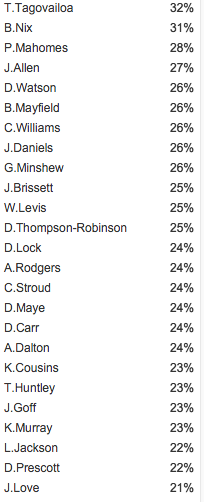Passing behind the line of scrimmage is the new NFL offense
There is no secret that the NFL game has changed tremendously over the years. Rules have changed or been modified, schemes are different, the emphasis on passing has increased, and more. However, there is change that seems to have gone unnoticed. Until now.
The passing game is targeting receivers behind the line of scrimmage more today than ever before. This change isn’t just a continued focus on short passing either. Throws that 0 to 4 air yards have decreased at a higher rate than any other distance. Passes with negative air yards are the new short passing game in the NFL.
In 2006, when air yards consistently began being tracked, completions with air yards less than 0 were 14% of all completions. That percent has increased almost every season since and in 2024 it was 22%. That is an increase of 57%. No other air yards distance has increase in that time period.
The short passing game (air yards between 0 and 4 yards) has decreased in the same metric. In 2006, it was 34% and today it is 30%. That is a decrease of 12%. Every air yard distance grouping had decreased but 0-4 has seen the largest by a considerable amount. Offensive coordinators are using negative distances at the expense of short positive passes. If the trend continues, the percent of completed passes behind the line of scrimmage will surpass 0-4 air yards in approximately ten seasons.
Below is a line graph representing completions behind the line of scrimmage and completions of 0-4 yards over time.
Offensive coordinators have become more focused on high completion percentage passes and are forcing their players to be playmakers now more than ever before.
There may be a few reasons for this new approach but the most obvious is to limit turnovers. Passing behind the line of scrimmage is the safest pass of any air yard distance. In fact, less than one percent of those pass attempts are intercepted. It is more than one percent from 0-4 yards and increases for each distance. It hits its peak at eight percent for 25+ air yards. The safest pass protects the ball.
The other reason has to do with sacks. The faster the ball gets out of the quarterback’s hands the less chance for a sack. This includes quick reads to the first option then a quick dump off to the running back behind the line if that first option isn’t available. As we have pointed out before, sacks are drive killers. This tactic is playing it very safe.
It is now an outdated philosophy when analysts try to diminish a quarterback because of a high number of passes behind the line of scrimmage. Perhaps in the past a coach would help his quarterback who had limited abilities by calling a higher percentage of those types of plays but now it is a philosophy across the NFL for every quarterback.
In 2006, the best quarterbacks who were known to use the short passing game frequently (recognizable names like Peyton Manning and Drew Brees) completed passes to receivers behind the line of scrimmage 16% of the time or less. In fact, only two qualifying quarterbacks had a percentage greater than 20%. Today, players like Patrick Mahomes and Josh Allen do it more than 25% and Mahomes in 2023 was above 30%. More than 25 qualifying quarterback had a percentage greater than 20%.
This is the new offensive philosophy in the NFL for most teams. Only three qualifying quarterbacks had completed pass percent behind the line of scrimmage below 15% in 2024. Fans need to get used to a more boring passing game and offensive skill players will need to become even more elusive.
Below is the list of 25 quarterbacks in 2024 with their percent of completions behind the line of scrimmage for reference.



